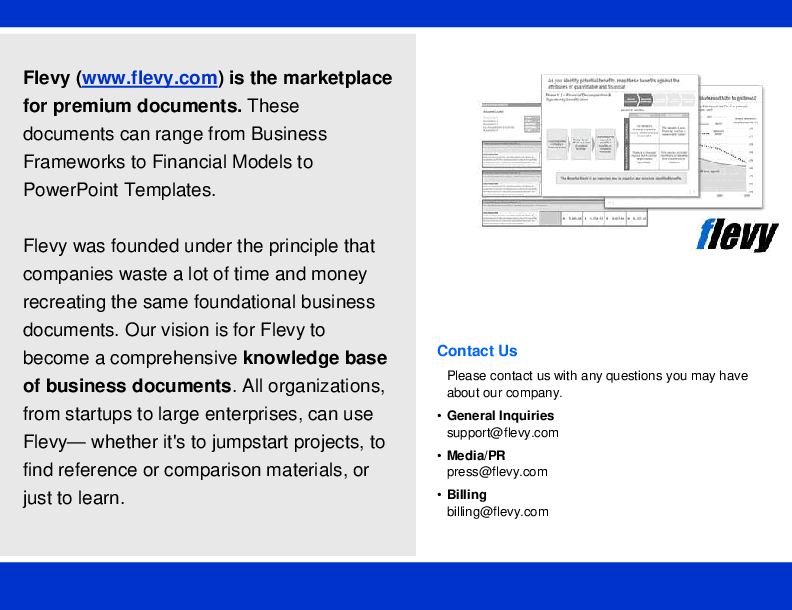Business Model Canvas (BMC) Poster (PDF)
PDF document + PowerPoint (PPTX) 3 Pages
BENEFITS OF THIS PDF DOCUMENT
- Provides a summary of the Business Model Canvas.
- Serves as a supplementary tool for your Value Proposition Canvas and/or Business Model Canvas awareness or workshop session.
- Print the poster in A3/A4 size right out from your office copier machine.
BUSINESS MODEL CANVAS PDF DESCRIPTION
The Business Model Canvas (BMC) is a Strategic Management and Lean Startup template for developing new or redesigning existing business models to create competitive advantage.
Based on the framework developed by Strategyzer, the BMC Poster is presented as a visual chart with 9 building blocks. These elements cover the areas of the organization's core offering, infrastructure, customers, and finances. They include: Customer Segments, Value Propositions, Channels, Customer Relationships, Revenue Streams, Key Resources, Key Activities, Key Partnerships and Cost Structure.
This innovative and increasingly popular tool can be used in a collaborative setting such as a strategic planning and deploymentworkshop. It helps organizations to align their activities by illustrating and discussing potential trade-offs in a structured manner. It is a hands-on tool that fosters understanding, discussion, creativity, and analysis.
The BMC poster is available in two distinct themes: a vibrant color scheme and a professional monochrome version. In both formats, the poster comes in a convenient PDF as well as an editable PPTX format, enabling effortless printing on A3/A4-sized paper from standard office copier machines. This versatile resource can be prominently displayed on employee workstations or distributed alongside your training materials.
The BMC Poster supplements the 'Value Proposition Canvas (VPC)' and 'Business Model Canvas (BMC)' training presentation materials. It serves as a takeaway and summary of your VPC and/or BMC presentation.
The BMC Poster is divided into four parts:
1. THE 9 BUILDING BLOCKS
• Customer Segments
• Value Propositions
• Channels
• Customer Relationships
• Revenue Streams
• Key Resources
• Key Activities
• Key Partnerships
• Cost Structure
2. THE ACRONYMS
• CS, VP, CH, CR, R$, KR, KA, KP and C$
3. DESCRIPTIONS OF THE BUILDING BLOCKS
• CS – The Customer Segments Building Block defines the different groups of people or organizations an enterprise aims to reach and serve.
• VP – The Value Propositions Building Block describes the bundle of products and services that create value for a specific Customer Segment
• CH – The Channels Building Block describes how a company communicates with and reaches its Customer Segments to deliver a Value Proposition
• CR – The Customer Relationships Building Block describes the types of relationships a company establishes with specific Customer Segments
• R$ – The Revenue Streams Building Block represents the cash a company generates from each Customer Segment (costs must be subtracted from revenues to create earnings)
• KR – The Key Resources Building Block describes the most important assets required to make a business model work
• KA – The Key Activities Building Block describes the most important things a company must do to make its business model work
• KP – The Key Partnerships Building Block describes the network of suppliers and partners that make the business model work
• C$ – The Cost Structure describes all costs incurred to operate a business model
4. KEY QUESTIONS
CS
• For whom are we creating value?
• Who are our most important customers?
VP
• What do we deliver to the customer?
• Which one of our customer's problems are we helping to solve?
• What bundles of products and services are we offering to each Customer Segment?
• Which customer needs are we satisfying?
CH
• Through which Channels do our Customer Segments want to be reached?
• How are we reaching them now?
• How are our Channels integrated?
• Which ones worked best?
• Which ones are most cost-efficient?
• How are we integrating them with customer routines?
CR
• What type of relationships does each of our Customer Segment expect us to establish and maintain with them?
• Which ones have we established?
• How are they integrated with the rest of our business model?
• How costly are they?
KR
• What Key Resources do our Value Propositions require?
• Our Distribution Channels?
• Customer Relationships?
• Revenue Streams?
KA
• What Key Activities do our Value Propositions require?
• Our Distribution Channels?
• Customer Relationships?
• Revenue Streams?
KP
• What are our Key Partners?
• Who are our Key Suppliers?
• Which Key Resources are we acquiring from partners?
• Which Key Activities do partners perform?
C$
• What are the most important costs inherent in our business model?
• Which Key Resources are most expensive?
• Which Key Activities are most expensive?
The BMC Poster is an essential tool for any organization aiming to streamline its strategic planning process. Its clear and structured format ensures that all team members are aligned and focused on the same objectives.
Got a question about the product? Email us at support@flevy.com or ask the author directly by using the "Ask the Author a Question" form. If you cannot view the preview above this document description, go here to view the large preview instead.
Source: Best Practices in Business Model Canvas PDF: Business Model Canvas (BMC) Poster PDF (PDF) Document, Operational Excellence Consulting



